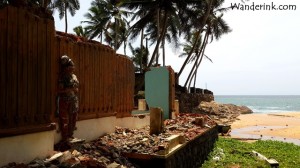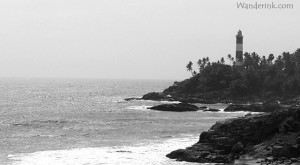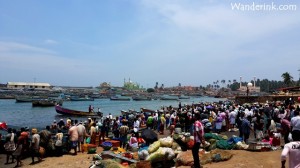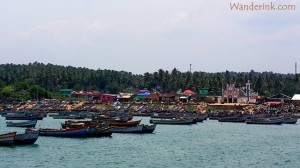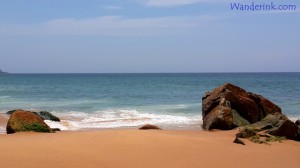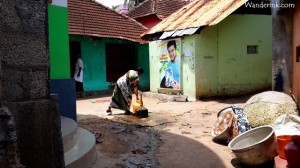“We the people…” Das shouted over the staccato din of his rear engine auto rickshaw “are full support of the port.”
Das and I were on our way to Mulloor, few kilometres from Vizhinjam, a flashpoint in the elaborate and controversial land acquisition exercise for the much touted Vizhinjam Port developed jointly by the state and central governments and infrastructure major Adani Group. “Only the priests and politicians have a problem.”
At the Kuriathy Beach in Mulloor resorts stood in rubbled desolation; while some acquiesced without fight, many waged court battles against the state machinery which they expectedly lost. “Some of them were demanding up to one crore rupees for a cent of land,” a surveyor at the specifically set up ‘Office of the Special Tehsildar – Land acquisition, Vizhinjam International Sea Port’ told me later, wide-eyed, still supercilious from an obvious whopper. “Of course they had to settle for less, way less.” Traditional Kerala ceilings with wooden beams and ornate corbels, decorated door jambs and window frames had been pried off and carted away; concrete walls remained roofless and burrowed out, stucco strewn all over. A buxom Kathakali dancer stood with folded arms and downcast eyes artfully resigned to fate; the peeling plaster of the caryatid portending a not very propitious one.
In the midst of a coconut grove slanting out of a laterite hill next to an Ayurvedic spa and resort which was curiously still taking in customers, stood the Azhimala Temple, briefly a most raucous spoke in the wheel of the ambitious land deals. Fears were allowed to suppurate that it might be razed which had local religious and civic organisations up in arms. Several baits were cast into the troubled waters but none came up trumps: Assurances were issued promptly enough allaying fears that the temple would not be touched. “This is India,” Das reminds me. “Nobody bulldozes a place of worship.”
“What if the 25,000 jobs promised by the port authorities were at stake?” I wondered.
“Not even then.”
This is India and I knew I had to believe.
—
The touristy Kovalam is next door – a 20 minute walk north from Vizhinjam along the beach. Many years ago as a student I have traipsed south from Kovalam with dates looking for secluded spots – plenty once you pass the lighthouse. This time I walked alone, the other way, nothing to stop me marvelling at the towering hillocks and boulders that jutted out into the sea. Some which were removed from the beach but still reachable had become standalone islets proper. The Arabian Sea stretched unending into the farthest southern and western horizons in the glistening virid of high noontide and dispatched walloping breakers over my feet. The powerful ebb scooped out copious quantities of sand from beneath my stride and threw me off-kilter. While the bigger motorised fishing boats had returned to harbour and arrayed themselves into neat bobbing rows, several smaller ones could be spotted out in the sea, little piddling flecks.
Not all boats were docked at the harbour. As I passed by a secluded stretch of the beach I saw some men waiting; weather-beaten faces anxiously following a pinnace fitted with an outboard motor tracing a wobbly path towards them. It stopped just short of the beach while expert hands tilted the motor on its mounting bracket just in time to prevent the propeller from scraping the sandy bottom. Sounds of dismay emanated from the onlookers who peered over the gunwale – the nets were empty, again. But they were soon back to work beaching the boat in cadenced heaves to the flow of tidewater. I was beckoned to lend a hand; trust me it is easier to park your car in Nehru Place during peak hours.
“Ports have historically sounded the death knell of fishing,” a wizened one with restless eyes told me lighting up an extra potent beedi specially rolled for seafarers. He offered me one and I was soon doubling over, cough-wracked.
The hackathon continued till I reached an exceptionally large hillock bordering Kovalam. From a distance the sea spray had it gleaming like a stranded colossal cetacean. Boulders and hillocks like these while protecting the coastline to an extent from erosion, are also instrumental in the sea gaining more depth – making it a fine natural harbour. Even sailors from centuries ago noted this feature of the area which made it safe for ships to come as close to the shore as possible enabling faster freight movement. Excavations carried out here by the Department of Archaeology of my erstwhile University of Kerala have thrown up ancient pottery, amphora and potsherds that point to trade relations with the Far East and even beyond. This led to the widely held belief that Vizhinjam could be the ‘Balita’ which is mentioned in The Periplus of the Erythraean Sea, a periplus for use by captains and traders written in Greek covering ports, coastal landmarks and commerce opportunities along the Red Sea, dating back to the mid first century.
—
Over the centuries with trade and commerce booming Vizhinjam became a prosperous port town. It also came to be sought-after by fortune-seeking kings and chieftains. Several sieges were laid on it by successive generations of rulers of the Pandya, Chera and Chola dynasties. Stone inscriptions found on a 10th century rock temple on the banks of the Thamirabarani River (‘Thamraparni’ in the olden days) in Tirunelveli, Tamil Nadu, have faithfully recorded the exploits of the Chola kings Rajaraja and his son Rajendra; the latter also called Gangaikonda Cholan for his military feats: He went as far as Malaysia, Sumatra and Sri Lanka and annexed large swathes of northern India as well. The earliest recorded military conquest of Vizhinjam was by the Pandya king Maravarman in the seventh century who then handed over the administration of the region to Ay chieftains renowned for their loyalty as well as building prowess. They constructed many forts in Vizhinjam including an ‘island fort’ for which the sea itself was the moat. References to this era can be found from the inscriptions on copper plates kept in the Chennai Museum dating back to the eighth century during the reign of the Pandya king Nedunjadaiyan.
Rajendra Chola conquered Vizhinjam from the Ay chieftains and the Pandyas in the 11th century and renamed in ‘Rajendracholappattinam.’ Before Rajendra Chola attacked, it was not just the Cholas who had designs on Vizhinjam but the valorous Cheras too. However since the Cheras were related to the Cholas by matrimony, they decided to hold peace. The alarms bells in the Chola camp were set off when the Cheras tried to enter into a strategic alliance with the Pandyas prompting Rajaraja Chola to attack first. Rajendra fortified further the Chola hegemony over Vizhinjam. The Pandyas regained Vizhinjam from the Cholas in the 13th century but couldn’t hold on to it for long. Several regional kings besieged the port town over the following centuries.
In 1505 the Dutch opened a pepper factory in Vizhinjam and forayed into gold, pearls and corals besides spices. Lured by the lucre, the British too set up shop here in 1644. However these were the final glorious years of Vizhinjam as an active trading port; the trading and the economy collapsed when they left. It was the Travancore kings who developed it into the fishing harbour as we know Vizhinjam today.
—
I reached Vizhinjam, 15 km from the Thampanoor bus terminal in Trivandrum on a sultry afternoon; no signs of the hyetal season which was to be underway. Posters featuring state chief minister Oommen Chandy with his trademark helter skelter hair and the delicately featured Shashi Tharoor who is the local area MP adorned every available space on the walls that led to the harbour. The message was a self-pat on the back for making the port happen, finally: Work is all set to commence November 1, Kerala Day. It had gone through several political regimes in the state but ran aground mostly over contentious land acquisition issues. The threat it posed to the livelihoods of fishermen was another.
The Port Action Council formed under the aegis of the Latin Church has laid the number of fishermen who depended on the Vizhinjam harbour at 35,000; 25,000 of whose livelihood it claimed would be affected by the development of the shipping channel. Besides rehabilitation packages running into several hundreds of crores of rupees, the state government has also promised around 25,000 jobs. Other carrots include a more advanced fishing harbour and a seafood park and basic facilities like drinking water. My beach expedition was marred in several places by emunctory invasions which made me hope if only the basic facilities would include toilets too. In a rehabilitation process that began years ago, many who lived in hutments and shacks on the beach were already shifted to hastily put up colonies peering over cliffs. These labyrinthine assortments of lean-tos and ramshackle dwellings have open drainages, shared taps and rarely proper toilets. Scatting in the open continues not as a matter of old habit but necessity.
A dearth of living area does not come in the way of play: Sports clubs can be spotted at every second corner. Here youngsters were seen bent over carom boards while older ones snoozed under the protective cover of the day’s edition of Deshabhimani and Mathrubhumi. Trophies – polished to a severe shine – lined the walls. These clubs were not all play either; but these are rooms where agitations are hatched, slogans devised and placards designed. These are also waiting rooms where those promised jobs at the port waits, weaving dreams.
“Most of the jobs are that of manual labourers – loading and unloading,” said Shahid, a sprightly young lad wearing green cigarette pants and cheap chequered cloth boat shoes. “But with my ITI diploma I hope to get a technical job.”
“I just hope to get any job so that I can marry my girlfriend before her father marries her off to somebody from the Gulf*,” said another.
*’Gulf’ in colloquial Malayalam comprises the countries of the Middle East – traditionally a hot job destination for Keralites.



